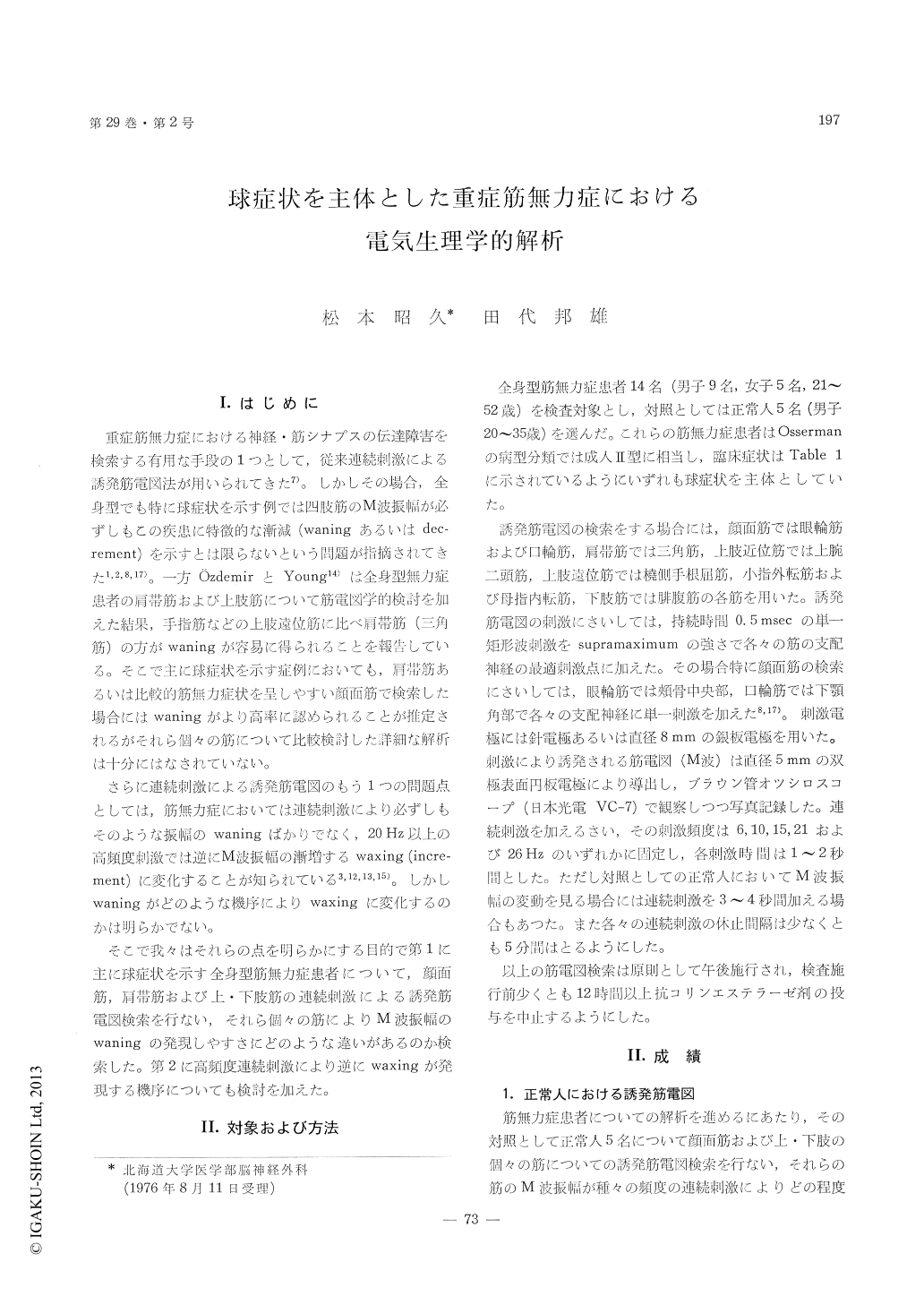Japanese
English
- 有料閲覧
- Abstract 文献概要
- 1ページ目 Look Inside
I.はじめに
重症筋無力症における神経・筋シナプスの伝達障害を検索する有用な手段の1つとして,従来連続刺激による誘発筋電図法が用いられてきた7)。しかしその場合,全身型でも特に球症状を示す例では四肢筋のM波振幅が必ずしもこの疾患に特徴的な漸減(waningあるいはdec—rement)を示すとは限らないという問題が指摘されてきた1,2,8,17)。一方ÖzdemirとYoung14)は全身型無力症患者の肩帯筋および上肢筋について筋電図学的検討を加えた結果,手指筋などの上肢遠位筋に比べ肩帯筋(三角筋)の方がwaningが容易に得られることを報告している。そこで主に球症状を示す症例においても,肩帯筋あるいは比較的筋無力症状を呈しやすい顔面筋で検索した場合にはwaningがより高率に認められることが推定されるがそれら個々の筋について比較検討した詳細な解析は十分にはなされていない。
さらに連続刺激による誘発筋電図のもう1つの問題点としては,筋無力症においては連続刺激により必ずしもそのような振幅のwaningばかりでなく,20Hz以上の高頻度刺激では逆にM波振幅の漸増するwaxing (incre—ment)に変化することが知られている3,12,13,15)。しかしwaningがどのような機序によりwaxingに変化するのかは明らかでない。
It is quite useful for the diagnosis of myasthenia gravis to test the changes of M-wave amplitudes elicited by the repetitive stimulation. However it has been obscure whether all muscles in a patient with myasthenia gravis showed the decrement of M-waves (waning) or not, especially, in case of the bulbar type. In order to solve this problem, we studied the evoked electromyogram of several muscles with 14 patients of the generalized my-asthenia gravis (age: 21-52 years old). The symptoms and signs of these patients were mainly the bulbar type with slight generalized weakness. As the results, when testing the face muscles such as M. orbiculi. oculi and M. orbicul. oris, the M-waves of the former muscle showed the waning in all cases (14 cases) at the stimulation of 6 Hz, and that of the latter muscle showed it in 11 cases at the stimulation of 6-10 Hz. However, other muscles such as shoulder muscle (Deltoid), and arm muscles (Biceps brachii., Flex. carp. rad., Abd. dig. Vm., and Add. pollicis) showed the waning only in a few case at the stimulation of 10 Hz. No waning was observed in all cases, when testing the leg muscle (Gastroc.). From these results, it was in-dicated that M. orbicul. oculi tends to show the waning most commonly in comparison with other muscles being tested. Accordingly it may be con-sidered that M. orbicul. oculi is one of the most available muscles for the electromyographic diag-nosis of myasthenia gravis.
As another problem in studying these evoked electromyogram, it has been known that, at the higher freqUency stimulation, the waning could be changed to the increment of M-waves (waxing). However the neural mechanism of this phenomenon has not been investigated in detail. In our experi-ment, such a waxing was also observed in several cases at the stimulation of 21-26 Hz. Furthermore our results demonstrated that, after termination of the repetitive stimulation, the augmented M-waves of the waxing gradually decreased to the control level with the duration of 20-30 sec. Therefore it was considered that such a waxing was produced by the similar mechanism to that of the post-tetanic potentiation. By gradually changing the intensity of repetitive stimulation from 1.7 T to the supramaximum, it was also suggested that the excitability change of the large motor fibers mainly played an important role for the production of waxing.

Copyright © 1977, Igaku-Shoin Ltd. All rights reserved.


